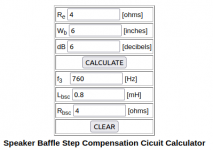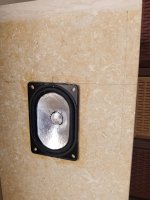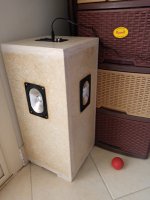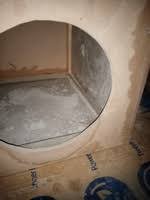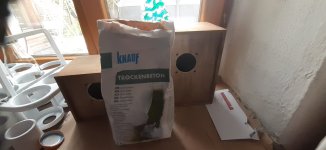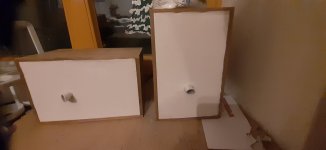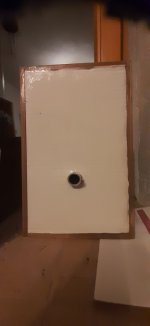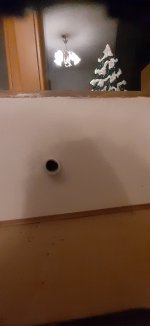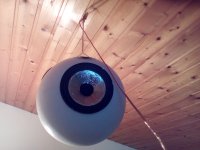Tapered line and folded horns are beyond me at this stage, though someone once suggested I build a Karlsonater. Maybe a cardboardsonater is in the future, but lets see.
I came across this video about baffle step and compensating for louder high frequencies in a box with a full range fitted to it. To be fair, Weems had something about it, and I did not want to get into building a crossover, however if I am ordering speaker drivers online then it only takes a few clicks and not a lot of money to order a crossover as well, or maybe the coil and resistor. The author talks about a -6dB reduction from I think 4,000 Hz upwards, of course I will try it on the EQ and see the effect.
https://diyaudioprojects.com/Technical/Baffle-Step-Correction-Circuit-Calculator/
Anyone build a full range with baffle step correction? I am sure it's out there, let's see the thread: Also full range forum.
https://www.diyaudio.com/community/...nsation-circuit-for-bookshelf-speaker.373969/
I came across this video about baffle step and compensating for louder high frequencies in a box with a full range fitted to it. To be fair, Weems had something about it, and I did not want to get into building a crossover, however if I am ordering speaker drivers online then it only takes a few clicks and not a lot of money to order a crossover as well, or maybe the coil and resistor. The author talks about a -6dB reduction from I think 4,000 Hz upwards, of course I will try it on the EQ and see the effect.
https://diyaudioprojects.com/Technical/Baffle-Step-Correction-Circuit-Calculator/
Anyone build a full range with baffle step correction? I am sure it's out there, let's see the thread: Also full range forum.
https://www.diyaudio.com/community/...nsation-circuit-for-bookshelf-speaker.373969/
Attachments
Better with TEA2025 amplifier board, it's a salvage from 20 years ago, so a bit ragged, but bass is good, and it is loud enough. The card speakers are fine with it. The G2 probably cut out the lows since they were not used in the small speaker, but with -6dB EQ is gets muffled enough.
So the open baffle speakers are.. good. Now to build the other one, right side.
Staying with either full range or single capacitor for the speaker if it is two way:
https://www.3squareaudio.com/what-is-a-crossover
Pic of TEA2025 (my board is more complex, from a PC speaker)

So the open baffle speakers are.. good. Now to build the other one, right side.
Staying with either full range or single capacitor for the speaker if it is two way:
https://www.3squareaudio.com/what-is-a-crossover
Pic of TEA2025 (my board is more complex, from a PC speaker)
Sounds good with the TEA. I listened to some songs and actually looked up who the drummer was. Impressive to hear all the sounds on a song.
I found that in this case, it was better to build a full enclosure mainly because the material was simply not stiff enough to withstand everyday use. Adding bracing at the top and bottom helped, but with one more side, the rear panel, it became a full enclosure, a box, and sound was greatly improved. The additional work and the additional material was worth using. It is the best speaker I have built so far. The speaker is designed to be on stands, one third of the way into the room, the improvement in sound is worth the arrangement, instead of attempting to achieve it artificially.
By the way, is sounds very good. Clear mids and highs and good cushy bass, yes, it may be the 'single bass note effect' but the overall sound is good.
This design is to be the basis for an MDF or plywood speaker cabinet, and although I arrived at the dimensions by experimentation, it has similar dimensions to the BBC LS3/5, but without the complex crossover. I did not realize the BBC speaker was so small:

https://www.diyaudio.com/community/...ange-speakers-and-stands.400936/#post-7394433
By the way, is sounds very good. Clear mids and highs and good cushy bass, yes, it may be the 'single bass note effect' but the overall sound is good.
This design is to be the basis for an MDF or plywood speaker cabinet, and although I arrived at the dimensions by experimentation, it has similar dimensions to the BBC LS3/5, but without the complex crossover. I did not realize the BBC speaker was so small:
| Dimensions (w/h/d) | 18.5cm by 30cm by 16.5cm https://www.grahamaudio.co.uk/products/ls35/ |
https://www.diyaudio.com/community/...ange-speakers-and-stands.400936/#post-7394433
Cardboard could be used quick and dirty for forming the enclosure. Put inside protecting plastic foil.
Then fill the sides with concrete. Let every side dry two days before going on.
However depends on the country you live.
This marble box I got for 20 Dollars ready made, without amp and drivers. Material and work included.
Then fill the sides with concrete. Let every side dry two days before going on.
However depends on the country you live.
This marble box I got for 20 Dollars ready made, without amp and drivers. Material and work included.
Attachments
I presume that you would need to use some reinforcement in the cement?
I've eyed up some "stone" plant pots with a view to using them as speaker enclosures
I've eyed up some "stone" plant pots with a view to using them as speaker enclosures
The cement is ready mixed concrete for floors. It's very good quality. When it's dry after some weeks it's very hard. 1 or 2 cm are better than a wooden enclosure.
You can combine thin wooden material for the looks and later you put some concrete and it forms a box in a box.
You can combine thin wooden material for the looks and later you put some concrete and it forms a box in a box.
What about making a wooden box (for the looks and ease of bolting on drivers/terminal posts, lining it with expanded polystyrene, then adding an internal concrete box.
You can take polystyrene, good idea.
Wood does not need to be lined. Cardboard is not allowed to get wet
Wood does not need to be lined. Cardboard is not allowed to get wet
You used to be able to get rolls of expanded polystyrene to put on walls, to cover with wall paper; my parents did this and it's amazing how much warmer the room was when they had finished - although the walls are a little squidgy. Unfortunately I haven't seen it since (possibly because polystyrene is supposed to give off a gas that "rots" PVC insulation, but if you could still get it, it could be like a constrained layer, or a bit like double glazing, it all depends if the concrete would stick to it.
If you put concrete into the box and turn it after 2 days and continue like this you get a "box in the box".
It's nice if it's bonded to the wood but does not need to for stability.
Cardboard if used as a form can be removed later.
Concrete is cheap. The method simple.
Sonically concrete gives you best results.
I often thought about using a well proportioned paper cardboard box for working with concrete but try to find some good looking wooden box when going to the markets.
It's nice if it's bonded to the wood but does not need to for stability.
Cardboard if used as a form can be removed later.
Concrete is cheap. The method simple.
Sonically concrete gives you best results.
I often thought about using a well proportioned paper cardboard box for working with concrete but try to find some good looking wooden box when going to the markets.
Constrained layer is not necessary because if thick enough concrete gives you best results in all aspects. Imho
In my eyes cardboard or Polystyrol boxes cannot sound well on their own.
I tried Polystyrol because of simplicity and it was catastrophic. I had to dampen the resonances and it made more work than using different box.
https://www.diyaudio.com/community/threads/full-range-speaker-photo-gallery.65061/post-7108160
I tried Polystyrol because of simplicity and it was catastrophic. I had to dampen the resonances and it made more work than using different box.
https://www.diyaudio.com/community/threads/full-range-speaker-photo-gallery.65061/post-7108160
Attachments
I've been put off by making concrete enclosures because of the faff of making the molds, but your method of " each side at a time" sounds so simple and practical. I see the main advantage as you are only molding a 1/2 inch depth of concrete at a time, so there is very little pressure acting on the mold. On my latest speakers, the driver goes in through a removable panel underneath and is held against the front baffle (with a soft foam gasket in-between the driver and baffle) by a compression spring, this would work well with a concrete enclosure because it would mean no screws are required. I like the idea of a house with almost nothing flamable in it.
- Home
- Loudspeakers
- Planars & Exotics
- Are cardboard enclosures any good?
